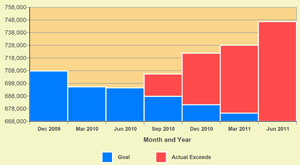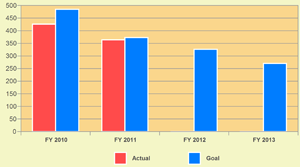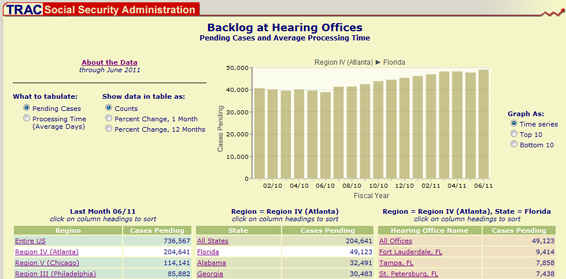The number of disability cases awaiting a hearing and decision by the Social Security Administration (SSA) continued to climb during the most recent quarter, from April 1 to June 30, 2011. Pending cases rose to 746,712 at the end of this period, up 7.5 percent from 694,417 one year ago.

Figure 1. Buildup in Pending Cases Continues. Click for larger image. |
According to an analysis by the Transactional Records Access Clearinghouse (TRAC) at Syracuse University, this is the fourth straight quarter when cases awaiting a hearing before the Office of Disability Adjudication and Review of the SSA have increased despite the agency's long standing objective to reduce the overall number of pending cases. See Figure 1 and supporting table.
SSA's Rationale for Reducing the Disability Hearing Backlog
SSA's performance goal for the current fiscal year was to bring down pending cases to 668,000, on their way to the agency's long-term target of reducing the hearing backlog and preventing its recurrence by keeping pending cases to no more than 466,000 by 2013. The SSA explained its rationale in setting these goals as follows:
For more than half a century, we [SSA] have helped disabled workers and their families cope with the loss of income caused by severe disability. Unfortunately, many of today's applicants for disability benefits face..[a] long wait… Tragically, individuals have died waiting for a hearing. The American people deserve better from their government." Source: SSA Strategic Plan, Fiscal Years 2008-2013
The SSA chose to reduce pending cases to 466,000 as its goal because it determined this was the level it could handle and decide cases in an average of 270 days, thus reducing typical wait times down to 9 months.
As TRAC reported earlier, the agency was making progress in achieving its goals until last summer when — despite significant staffing increases — it was no longer able to keep up with the rising tide of new disability hearing requests. The fact that pending cases have steadily climbed rather than declined for four successive quarters seriously imperils the agency's ability to achieve its stated goals.
SSA's Related Goal to Reduce Average Decision Times to 270 Days
As of June 2011, SSA reports that it took an average of about a year (364 days) to process a case during FY 2011. This is a decline from three months ago when the average wait time was 369 days. As a result it has already met the target set for FY 2011.
While the trends continue in the right direction on processing times, the pace of change during the last quarter was slower than in previous quarters. And during June, the number of cases that had been waiting over 270 days increased slightly to 214,440, from 214,048 in May 2011.

Figure 2. Average Days to Process Case. Click for larger image. |
Because the increase in the backlog of pending cases is very recent and cases must wait awhile before a hearing can be scheduled, the impact of the rising workloads will take time before these cases reach the decision stage and are fully reflected in the calculation of processing times.
While considerable progress has been made, the agency's goal of reducing average processing days to 326 days next year and to 270 days in 2013 will require that the pace of cutting its processing times not slacken. See Figure 2 and supporting table. These gains are threatened by the recent growing volume of pending cases. History shows that if this growth is unchecked, as hearing dockets become more and more clogged, wait times will grow.
Trends by SSA Hearing Office
These national averages in wait times conceal widely varying situations in different hearing offices. In cases disposed of during June 2011, average processing times ranged between 161 days in Ponce, Puerto Rico and 168 days in Shreveport, Louisiana to 544 days in Cleveland, Ohio and 509 days in Springfield, Missouri. For the 162 hearing offices, this was a difference in average times between the slowest and fastest offices of 383 days.
In March of 2011, as TRAC noted in its previous report, processing times then varied between 162 days and 535 days, a range of 373 days.
Thus, there has been little improvement in the widely differing times which claimants experience depending upon their location. In fact, variability increased slightly and the longest average wait in June was nine days longer than in March.
|
Table 1. Disability Processing Time
(Cases closed in June 2011)
|
Table 1 shows the top 10 hearing offices with the longest average processing times for cases closed during June 2011. All but 3 were located in the Midwest. A National Hearing Center (NHC) in Chicago — centers that the SSA set up to speed the processing of cases — actually made the top 10 list as one of the locations with the slowest processing times in June.
While nationally the average processing times are still declining, the changes are at a slowing rate and the number of hearing offices that experienced increased processing times is growing. Almost half (47 percent) of all hearing offices saw their average hearing times increase in June as compared with the previous month. And for one in six hearing offices the increase in average hearing times had been increasing over the past year.
You can examine trends in both pending caseloads and average disposition times by region, state, and by each of the 162 separate court hearing offices in the accompanying app, now updated through June 2011.

Figure 3. TRAC's Social Security Administration Case Backlog Tool. (click to use the tool) |